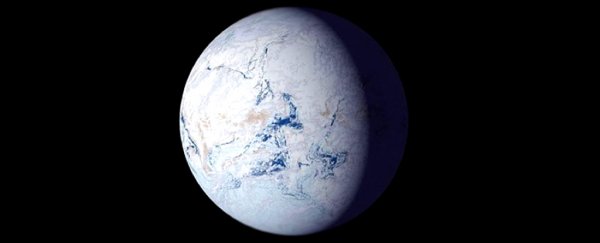Not all ice ages are equally brutal. In the most extreme glaciation events known to science, ice stretches out from Earth's polar regions and extends all the way into lower latitudes, literally reshaping the face of the planet.
Evidence for such epic transitions can be found in the geologic record, most recently in formidable glaciations during the Cryogenian period. Scientists think these extreme cooling events had potentially global reach and ramifications: a phenomenon called 'Snowball Earth'.
But what on Earth could unleash such devastating, unrelenting cold that most - or all - of our planet would end up sheathed in a frozen sphere of ice and snow? While the exact triggers remain unknown, researchers have now unearthed a new theoretical explanation for how such a thing could happen.
"There are lots of ideas for what caused these global glaciations, but they all really boil down to some implicit modification of solar radiation coming in," says planetary science researcher Constantin Arnscheidt from MIT.
"But generally it's been studied in the context of crossing a threshold."
In other words, the conventional explanation for how a Snowball Earth could transpire is that, in some kind of cataclysmic throwing of shade, a reduced amount of sunlight would reach the surface of the planet, resulting in a cooler Earth that proceeds to freeze over.
Another hypothetical explanation, to do with the carbon cycle, would be the opposite of the global warming crisis facing Earth now: what if our planet had so little heat-trapping carbon dioxide in the atmosphere that we lost Earth's temperate climate altogether, with its warmth drifting off into space?
"Although there remains debate about the specific triggers of the low-latitude glaciations in Earth's geologic past, there is a general understanding that glaciation is initiated when changes in radiative fluxes or in CO2 fluxes exceed a critical threshold," Arnscheidt and his co-author, MIT geophysicist Daniel Rothman, explain in a new paper.
While the theory has focused on such critical thresholds before, the researchers have struck upon a new avenue for thinking about Snowball Earth precursors: what if it wasn't a critical threshold that was met (in terms of solar radiation plunging, for example), but a critical rate of change that was reached?
In new modelling, the researchers simulated Earth's dynamic systems in glaciation scenarios – chiefly the interplay of ice-albedo feedback and the carbonate-silicate cycle.
The former is an example of positive feedback. As Earth gets icier and approaches Snowball Earth, it's frosty coat of ice and snow end up reflecting more sunlight away from the planet, which in turn accelerates the cooling effects already in process.
However, as Earth becomes icier, our usual carbonate–silicate cycle becomes disrupted. With Earth's rocks sealed under ice, they're less able to absorb atmospheric carbon, so it sticks around in the air trapping heat. That's why – at Earth's distance from the Sun, anyhow – our planet theoretically wouldn't get stuck in a permanent Snowball Earth state, despite the perpetuation of ice–albedo feedback.
With these kinds of factors built into their models, the researchers examined whether rate-induced tipping might induce a Snowball Earth event. In the right circumstances, it did.
In the simulations, Arnscheidt and Rothman found that if solar radiation dropped quickly enough for long enough, that in itself could be enough to unleash a Snowball Earth – and all it might take would be about a 2 percent drop in sunlight reaching the surface for 10,000 years, the researchers estimate.
In the grand scheme of things (read: Earth's approximate 4.5 billion years of age), that's not very long. But what could hide Earth from the Sun like that, for 10,000 years at a stretch?
Nobody really knows for sure, but it's plausible that something like a planetary-scale volcanic winter unleashed by volcanic eruptions might sufficiently cloud our atmosphere. Alternatively, some kind of biological phenomenon in Earth's ancient past, like a surge in moisture-producing algae, could generate clouds of condensation that might ultimately freeze them and everything else into oblivion.
Of course, all these ideas are pretty out there. But that doesn't mean we shouldn't go looking for what might have made Snowball Earth eventuate, or exploring how quickly this ancient, icy history may have unfolded.
Especially given we're right now rushing so fast in the opposite direction, the researchers say.
"It teaches us that we should be wary of the speed at which we are modifying Earth's climate, not just the magnitude of the change," Arnscheidt says.
"There could be other such rate-induced tipping points that might be triggered by anthropogenic warming."
The findings are reported in Proceedings of the Royal Society A.
